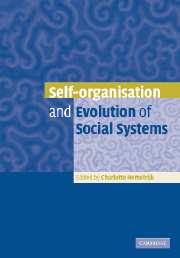Book contents
- Frontmatter
- Contents
- List of contributors
- Preface
- Introduction
- 1 From unicellular to multicellular organisation in the social amoeba Dictyostelium discoideum
- 2 Optimality of communication in self-organised social behaviour
- 3 The interplay of intracolonial genotypic variance and self-organisation of dominance hierarchies in honeybees
- 4 Traffic rules of fish schools: a review of agent-based approaches
- 5 A process-oriented approach to the social behaviour of primates
- 6 Order and noise in primate societies
- 7 Self-organisation in language
- 8 Dictatorship effect of majority rule in voting in hierarchical systems
- 9 Natural selection and complex systems: a complex interaction
- 10 Interlocking of self-organisation and evolution
- Index
- References
Introduction
Published online by Cambridge University Press: 07 December 2009
- Frontmatter
- Contents
- List of contributors
- Preface
- Introduction
- 1 From unicellular to multicellular organisation in the social amoeba Dictyostelium discoideum
- 2 Optimality of communication in self-organised social behaviour
- 3 The interplay of intracolonial genotypic variance and self-organisation of dominance hierarchies in honeybees
- 4 Traffic rules of fish schools: a review of agent-based approaches
- 5 A process-oriented approach to the social behaviour of primates
- 6 Order and noise in primate societies
- 7 Self-organisation in language
- 8 Dictatorship effect of majority rule in voting in hierarchical systems
- 9 Natural selection and complex systems: a complex interaction
- 10 Interlocking of self-organisation and evolution
- Index
- References
Summary
This book contains a collection of studies of social behaviour that are mainly biologically oriented and are carried out from the perspective of emergent effects and of self-organisation. It brings together papers that show emergent aspects of social behaviour through interaction with the environment in the entire range of organisms (from single-celled organisms via slugs, insects, fish and primates to humans). This book treats the broadest range of organisms as regards self-organisation and social behaviour that has been treated so far in one book. It is only followed by the book by Camazine et al. (2001) in which mostly insect societies are emphasised. Most of the papers deal with the direct effect of self-organisation on patterns of social behaviour. We will treat them in increasing order of complexity from slime moulds to humans (Chapters 1–8). A few papers discuss the intricate relationship between evolution and self-organisation (Chapters 9 and 10).
Before treating each of the papers in turn, a few words about self-organisation and emergent effects by interaction with the environment are needed.
Emergent phenomena arise in social systems as a consequence of self-reinforcing effects and of ‘locality’ of interactions, as explained below. Self-reinforcing effects imply that if an event takes place, it increases the likelihood that it will happen again. An example is population growth. The larger a population gets, the more individuals it contains that can bear new offspring.
- Type
- Chapter
- Information
- Publisher: Cambridge University PressPrint publication year: 2005



